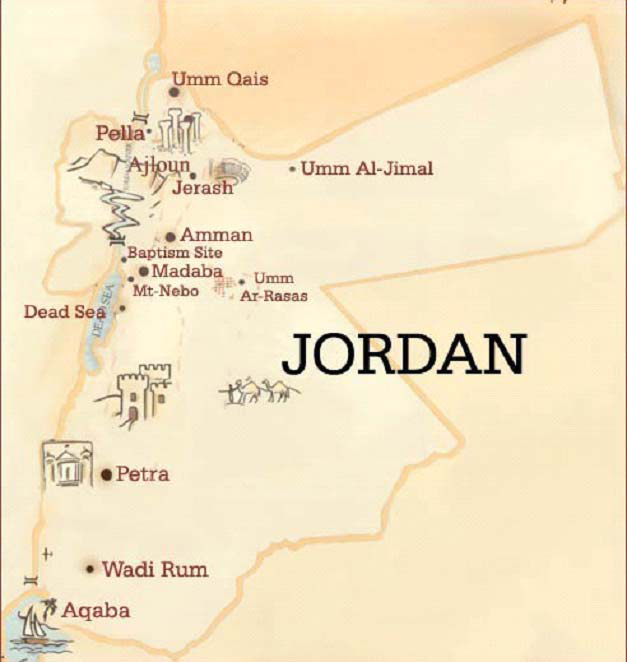|
“Go up into the Abarim Range to Mount Nebo in Moab, across from Jericho, and view Canaan, the land I am giving the Israelites as their own possession.” (Deuteronomy 32:49) Along with that instruction, God tells Moses he is going to die on Mount Nebo. God plans to show Moses everything the Israelites will eventually possess but warns Moses that he will never go there himself. This is Moses’ punishment for breaking faith with God in the presence of the Israelites and because he did not uphold God’s holiness among them. Despite the years of wandering in the wilderness, Moses will only see the land from a distance.
Moses’ death occurs in Deuteronomy 34 where we are told, “Then Moses climbed Mount Nebo from the plains of Moab to the top of Pisgah, across from Jericho.” (34:1a) Before he dies, God reveals to Moses the land He promised Abraham, Isaac and Jacob. “There the Lord showed him the whole land—from Gilead to Dan, all of Naphtali, the territory of Ephraim and Manasseh, all the land of Judah as far as the Mediterranean Sea the Negev and the whole region from the Valley of Jericho, the City of Palms, as far as Zoar.” (34:1b-3) These are the only two references of Mount Nebo in the Bible, however, as it is the death place of Moses, it is included amongst the list of important biblical mountains. Deuteronomy tells us that Mount Nebo is in Moab; this is the name of an ancient kingdom in the land now known as Jordan. It was a mountainous area bordered by the Dead Sea and the Arabian Desert. The inhabitants of the kingdom were ancestors of Lot via his eldest daughter and it is believed they thrived until around 400 BC. Mount Nebo is an elevated ridge within the Abarim range in Jordan. It is approximately 2330 feet above sea level and provides extensive views over the surrounding land. It is possible to see as far as the River Jordan from one angle and Jericho from another. On a very clear day, the city of Jerusalem can be seen in the far distance. Although it is not specified in the Bible, some Christians have assumed that Moses was buried on the mountain. This is also true within some Islamic traditions; however, there is also a tomb to the east of Jerusalem in the Judean wilderness that claims to be Moses’ resting place. To complicate matters, scholars are still debating whether today’s Mount Nebo is the same place as the Mount Nebo mentioned in Deuteronomy. To date, there has been no sign of a tomb at the summit. In the deuterocanonical book 2 Maccabees, the writer claims the prophet Jeremiah hid the Ark of the Covenant in a cave on Mount Nebo. Once again, there has been no archaeological evidence of this and, being a non-canonical book, it is not certain how much of the recorded events are true. In 1933, the remains of a Byzantine church and monastery were discovered on the highest part of the mountain. The church was built during the 4thcentury to mark the location of Moses’ death. It appears to have been enlarged during the 5thcentury, however, was first mentioned in AD 394 in an account of a pilgrimage to the Holy Land made by a lady known as Etheria. The surviving text recounts Etheria’s journey from Mount Sinai to Constantinople, during which she stayed in Jerusalem for three years, making excursions to Mount Nebo and to the tomb of Job in what is now Syria. Six tombs have been discovered in the natural rock beneath the mosaic-covered floor of the church. No one knows who they belong to but, judging by the date of the church building, not Moses. A modern chapel has been erected on the site of the Byzantine church to protect the ancient remains. Mosaics have been preserved from different periods to give people an idea of the decoration of the original church. It is also regularly used as a place of worship. In 2000, Pope John Paul II made Mount Nebo one of his destinations during his pilgrimage to the Holy Land. When visiting the remains of the ancient church, he planted an olive tree as a symbol of peace. Later, in 2009, Pope Benedict XVI also visited the site, giving a speech from the top of the mountain in the direction of Jerusalem. As well as the chapel, tourists climb Mount Nebo to see the serpentine cross sculpture created by the Italian artist Giovanni Fantoni. The sculpture symbolises the bronze serpent Moses made in Numbers 21:9. “So Moses made a serpent of bronze, and put it upon a pole; and whenever a serpent bit someone, that person would look at the serpent of bronze and live.” The cross on top of the sculpture symbolises Jesus’ crucifixion. Just for fun, I have looked up all the things tourists photograph when visiting Mount Nebo:
0 Comments
Your comment will be posted after it is approved.
Leave a Reply. |
©Copyright
We are happy for you to use any material found here, however, please acknowledge the source: www.gantshillurc.co.uk AuthorRev'd Martin Wheadon Archives
June 2024
Categories
All
|

 RSS Feed
RSS Feed